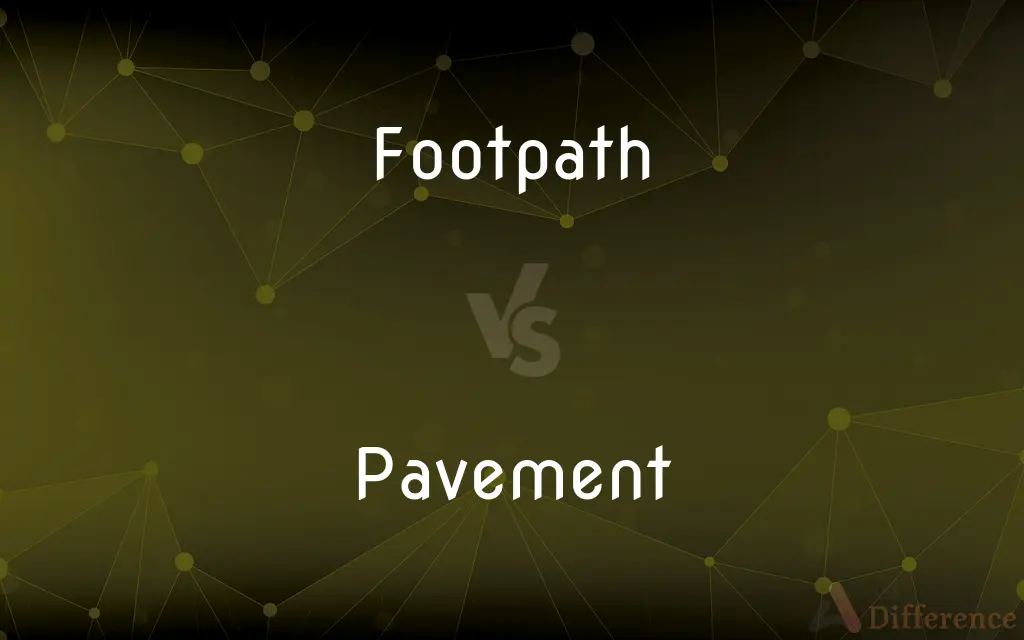Footpath vs. Pavement — What's the Difference?
By Tayyaba Rehman & Maham Liaqat — Updated on March 11, 2024
A footpath is a narrow path for pedestrians, often unpaved and located in rural or natural settings, while pavement refers to the hard surface of roads and sidewalks, typically made of concrete or asphalt in urban areas.

Difference Between Footpath and Pavement
Table of Contents
ADVERTISEMENT
Key Differences
A footpath is designed primarily for pedestrian use and is often found in rural areas, parks, and natural reserves. It is typically unpaved, consisting of dirt, gravel, or grass, and follows the natural contours of the landscape. Conversely, pavement is a term used to describe the hard, durable surface material used in constructing roads, sidewalks, and walkways, usually in urban and suburban settings. Pavements are made from materials like concrete, asphalt, or bricks, providing a smooth and stable surface for pedestrian and vehicular traffic.
Footpaths are usually narrower and less formal than paved paths, offering a more intimate connection with the surrounding environment. They can meander through woods, fields, and along riverbanks, adapting to the terrain and often providing scenic views or access to natural features. On the other hand, pavements are part of planned infrastructure, designed to facilitate efficient movement within populated areas. They are built to certain standards to ensure safety, durability, and accessibility, including for those with mobility impairments.
The maintenance of footpaths can vary significantly depending on their location and the responsible authorities. In natural reserves or parks, maintenance might involve clearing debris, ensuring the path is passable, and minimal intervention to preserve the natural setting. Pavements, due to their construction materials and urban location, require regular maintenance to fix cracks, potholes, and other wear and tear caused by heavy use and weather conditions.
Footpaths can sometimes be part of a network of trails that link different areas, offering recreational and commuting options for pedestrians and sometimes cyclists. Pavements, particularly those in cities, are an integral part of the urban landscape, ensuring the safe coexistence of pedestrians, cyclists, and vehicles. They are crucial for pedestrian accessibility, including sidewalks that line streets, providing safe pathways separated from vehicular traffic.
Culturally, footpaths can hold historical or recreational significance, representing ancient routes used by people for travel or trade. They can be cherished parts of community heritage, offering insights into how ancestors interacted with the landscape. Pavements, while more functional in nature, play a vital role in urban design and development, influencing how cities evolve and how people experience and navigate urban environments.
ADVERTISEMENT
Comparison Chart
Location
Rural areas, parks, natural reserves
Urban and suburban areas
Surface Material
Natural materials like dirt, gravel, or grass
Constructed materials like concrete, asphalt, or bricks
Purpose
Recreational walking, hiking, access to nature
Facilitating pedestrian and vehicular traffic
Maintenance
Minimal, focused on preserving natural surroundings
Regular, to repair wear and tear and ensure safety
Cultural Significance
Can represent historical or recreational trails
Integral to urban design and development
Compare with Definitions
Footpath
Popular for hiking, walking, and enjoying nature.
The footpath leads to a secluded picnic area by the river.
Pavement
Hard surfaces used for sidewalks and roads.
The city recently renovated the pavement along Main Street to improve walkability.
Footpath
A trail designed for walking, often through natural areas.
The footpath wound through the forest, offering stunning views of the landscape.
Pavement
Made from concrete, asphalt, or similar materials.
The new pavement used recycled materials for a more sustainable approach.
Footpath
Focuses on keeping the path clear and safe.
The park rangers regularly check the footpath for fallen branches and other obstacles.
Pavement
Influences urban aesthetics and functionality.
The patterned pavement in the downtown area enhances the city's historic charm.
Footpath
Offers access to natural and scenic areas.
The footpath connects several key viewpoints within the national park.
Pavement
Ensures safe pedestrian and vehicular traffic.
The wide pavement accommodates both pedestrians and cyclists comfortably.
Footpath
Typically consists of dirt, gravel, or grass.
The footpath's gravel surface was well-maintained, making for an easy hike.
Pavement
To address wear and ensure safety.
The municipality has a yearly schedule for pavement maintenance and repair.
Footpath
A narrow path for persons on foot.
Pavement
A hard smooth surface, especially of a public area or thoroughfare, that will bear travel.
Footpath
A footpath (also pedestrian way, walking trail, nature trail) is a type of thoroughfare that is intended for use only by pedestrians and not other forms of traffic such as motorized vehicles, cycles, and horses. They can be found in a wide variety of places, from the centre of cities, to farmland, to mountain ridges.
Pavement
The material with which such a surface is made.
Footpath
Any set path or trail to be used by people walking.
Pavement
Chiefly British A sidewalk.
Footpath
A paved path located at the side of a road for the use of pedestrians.
Pavement
A paved surface; a hard covering on the ground.
Footpath
A narrow path or way for pedestrains only; a footway.
Pavement
A paved path, for the use of pedestrians, located at the side of a road.
Footpath
A trodden path
Pavement
A paving (paved part) of a road or other thoroughfare; the roadway or road surface.
Pavement
The paved part of an area other than a road or sidewalk, such as a cobblestone plaza, asphalt schoolyard or playground, or parking lot.
Pavement
(architecture) The interior flooring of a church sanctuary, between the communion rail and the altar.
Pavement
That with which anything is paved; a floor or covering of solid material, laid so as to make a hard and convenient surface for travel; a paved road or sidewalk; a decorative interior floor of tiles or colored bricks.
The riches of heaven's pavement, trodden gold.
Pavement
To furnish with a pavement; to pave.
Pavement
The paved surface of a thoroughfare
Pavement
Material used to pave an area
Pavement
Walk consisting of a paved area for pedestrians; usually beside a street or roadway
Common Curiosities
What defines a footpath?
A footpath is a narrow path intended for pedestrians, often unpaved and located in natural settings.
Can footpaths be found in urban areas?
While more common in rural settings, footpaths can also be part of urban parks and greenways.
How often do pavements need to be replaced?
The lifespan of pavement depends on material, usage, and maintenance, but it can last several decades with proper care.
How does pavement contribute to urban planning?
Pavement is essential for creating walkable, accessible urban environments, facilitating safe movement and transportation.
What materials are used for pavement?
Pavement is typically made from durable materials like concrete, asphalt, or bricks.
Can pavements be environmentally friendly?
Yes, using sustainable materials and construction methods can make pavements more environmentally friendly.
Can footpaths be part of historical trails?
Yes, many footpaths follow historical routes and can offer insights into cultural and historical landscapes.
Are footpaths accessible to everyone?
Footpaths can vary in accessibility; some may be suitable for a wide range of users, while others might be challenging for those with mobility issues.
Can pavements have decorative elements?
Yes, pavements can include decorative patterns, colors, and materials to enhance aesthetic appeal.
What are the challenges of maintaining urban pavements?
Urban pavements face challenges from heavy use, weather conditions, and the need for regular maintenance to ensure safety and durability.
What is the main purpose of pavement in cities?
The main purpose is to provide a safe and durable surface for pedestrian and vehicular traffic.
Are there any regulations governing the construction of footpaths?
Regulations can vary by location but generally focus on ensuring safety and preserving the natural environment.
Do footpaths contribute to environmental conservation?
Yes, by providing natural walking routes, footpaths can help reduce reliance on vehicles and promote conservation of natural areas.
How do footpaths enhance recreational experiences?
Footpaths offer scenic routes for walking, hiking, and connecting with nature, enhancing outdoor recreational opportunities.
How do pavements impact urban heat islands?
Pavements can contribute to urban heat islands due to their heat-absorbing materials, but reflective surfaces and green infrastructure can mitigate this effect.
Share Your Discovery

Previous Comparison
Process vs. Program
Next Comparison
Rock vs. MetalAuthor Spotlight
Written by
Tayyaba RehmanTayyaba Rehman is a distinguished writer, currently serving as a primary contributor to askdifference.com. As a researcher in semantics and etymology, Tayyaba's passion for the complexity of languages and their distinctions has found a perfect home on the platform. Tayyaba delves into the intricacies of language, distinguishing between commonly confused words and phrases, thereby providing clarity for readers worldwide.
Co-written by
Maham Liaqat













































